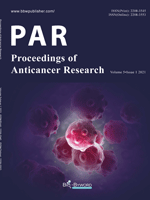Epidemiological Characteristics and Genotypes of Human Papillomavirus Infection in Mianyang
Abstract
Objective: To investigate the epidemiological characteristics and genotypes of human papillomavirus (HPV) infection in Mianyang. Methods: The cervical samples of 27,040 patients, who visited the Department of Gynecology of The Third Hospital of Mianyang from January 2018 to January 2020, were collected. Results: The HPV-positive infection rate was 21.40% (5,787/27,040); the single HPV infection rate was 72.04% (4,169/5,787); the double HPV infection rate was 19.73% (1,142/5,787); the triple and above HPV infection rate was 8.22% (476/5,787); the top five high-risk HPV subtypes with the highest infection rates were HPV52, 16, 58, 53, and 51, while the top five low-risk HPV subtypes with the highest infection rates were HPV81, 42, 43, 6, and 11; there were significant differences in the HPV-positive infection rate, high-risk infection rate, low-risk infection rate, and multiple infection rate among different age groups (P < 0.05). Conclusion: The HPV infection rate in Mianyang was 21.4%, in which the majority of the cases were single infection; the high-risk HPV subtypes were HPV52, 16, 58, 53, and 51; the HPV-positive infection rate, high-risk infection rate, low-risk infection rate, and multiple infection rate were high in the middle but low at both ends in the context of age distribution; the top three age groups with the highest infection rates were 45-49, 40-44, and 30-34.
References
Dong B, Sun P, Ruan G, et al., 2018, Type?Specific High?Risk Human Papillomavirus Viral Load as a Viable Triage Indicator for High?Grade Squamous Intraepithelial Lesion: A Nested Case?Control Study. Cancer Manage Res, 10: 4839-4851.
Patti E, Rachel L, 2017, Natural History of HPV Infection Across the Lifespan: Role of Viral Latency. Viruses, 9(10): 267.
Szymonowicz KA, Chen J, 2020, Biological and Clinical Aspects of HPV-Related Cancers. Cancer Biol Med, 17(4): 864-878.
Wang Y, Lin W, Wu B, et al., 2018, Distribution and Related Factors of HPV High-risk Subtypes among HPV Positive Patients with Cervical Cancer Screening in Shenzhen from 2014 to 2016. Chinese Journal of Preventive Medicine, 52(5): 480-485.
Wang Y, Chen Y, Zheng J, et al., 2020, Relationship between HPV-52 Infection and Cervical Squamous Epithelial Lesions in Shantou Women. Carcinogenesis, Teratogenesis & Mutagenesis, 32(4): 304-308.
Li Y, Wang H, Zhang Y, et al., 2021, Correlation between Multi-Type Human Papillomavirus Infections and Viral Loads and the Cervical Pathological Grade. Int J Gynecol Obstet, 152: 96-102.
Liu Y, Ang Q, Wu H, et al., 2020, Prevalence of Human Papillomavirus Genotypes and Precancerous Cervical Lesions in a Screening Population in Beijing, China: Analysis of Results from China’s Top 3 Hospital, 2009-2019. Virol J, 17(1): 104.
Li M, Du X, Lu M, et al., 2019, Prevalence Characteristics of Single and Multiple HPV Infections in Women with Cervical Cancer and Precancerous Lesions in Beijing, China. J Med Virol, 91: 473-481.
Luo Z, Leng P, Liu X, et al., 2018, Epidemiological Characteristics of HPV Infection in Women in Chengdu and Its Relationship with Cervical Lesions. Journal of International Reproductive Health/Family, 37(1): 49-53.
Yuan F, Xu P, He X, et al., 2020, Epidemiological Analysis of 37799 Cases of Cervical Human Papillomavirus in Deyang Area. Chinese Journal of Family Planning & Gynecology, 12(3): 56-59.

